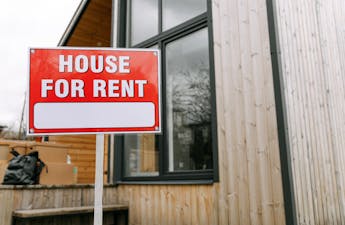Whether you’re a new landlord or a seasoned investor, understanding how much to charge for rent is a skill that can make or break your investment’s success. In this comprehensive guide, we dive into the importance of proper rent pricing and how it affects profitability. We also share ways to help you determine the right rent for your property. By the end, you’ll be equipped with the knowledge you need to navigate the intricate world of rent pricing and ensure your rental property thrives in today’s competitive market.
Why Is Proper Rent Pricing Important?
Setting the right rent price for your property is a pivotal decision that significantly impacts your success as a landlord. Finding the sweet spot ensures a harmonious balance between attracting ideal tenants and maximizing your rental income.
If you price your property too low, you risk missing out on potential higher rental income. While this may attract tenants quickly, it could also attract those who might not align with your property’s quality or long-term goals. Moreover, undervaluing your property means you’re leaving money on the table, which could have been earned through higher rent.
Conversely, if you set the rent too high, you might encounter difficulties in attracting tenants. Prospective renters are savvy and compare prices. They may overlook an overpriced property in favor of more reasonably priced alternatives. Additionally, keeping your property vacant for extended periods due to unreasonably high rent can lead to significant income loss, ultimately outweighing the potential gain from higher rent.
How Can Rent Pricing Affect Profitability?
The impact of rent pricing on your rental property’s profitability is a crucial consideration. Striking the right balance between rental income and occupancy rates plays a pivotal role in maximizing your investment’s financial success.
Opting for a higher rent might seem appealing, as it promises greater revenue potential. However, this could lead to prolonged vacancy periods, during which you’ll generate no income at all. The trade-off here involves finding the equilibrium between setting a premium rent and the time it takes to secure a tenant. While the higher rent might offer better returns in the long run, the extended vacancy could potentially offset those gains.
On the flip side, setting a slightly lower rent could accelerate the occupancy process, ensuring a steady stream of income sooner. While each month’s rent might be slightly less than the premium rate, the consistent rental income could prove advantageous over time.
Let’s consider an example:
Property A rents at $1,500 per month, and Property B at $1,300 per month. Property A takes three months to find a tenant, while Property B is filled within a month. Over the course of a year, Property A accumulates $13,500 (after accounting for three months of vacancy), while Property B earns $14,300 (after accounting for a month of vacancy).
In this example, even though Property A has a higher rent per month, the extended vacancy period results in Property B actually generating more income for a year.

Determining Rent Price
Different Methods to Help Determine Rent Price
When it comes to setting the perfect rent price for your property, landlords have a variety of approaches at their disposal. Each method provides a unique perspective, allowing you to make an informed decision that aligns with your investment goals.
- 1% Rule and 2% Rule: These rules are quick benchmarks to estimate rent. The 1% rule suggests charging at least 1% of the property’s purchase price in monthly rent, while the 2% rule doubles that percentage. However, these rules don’t consider specific property details.
- Gross Rent Multiplier (GRM): GRM involves dividing the property’s purchase price by the annual rental income. It’s a simplified method that doesn’t account for expenses.
- Capitalization Rate (Cap Rate): The cap rate evaluates the property’s potential return by comparing the net operating income to the property’s value. It’s valuable for comparing investment opportunities.
- Internal Rate of Return (IRR): IRR factors in projected cash flows over time, considering the time value of money. It offers a more comprehensive view of investment returns.
Things You Should Consider
Determining rent isn’t just about formulas; it’s about understanding your property, its market, and your financial goals. Consider these factors to refine your rent pricing strategy:
- Comparables: Analyze similar properties in your area to gauge market rates accurately.
- Rental Market Analysis (RMA): Dive into your local rental market’s trends, demand, and supply.
- Seasonality: Understand how rental demand changes throughout the year.
- Amenities: Property features and nearby amenities can influence your property’s value.
- Costs: Factor in property expenses, maintenance, taxes, and management fees.
Best Rental Estimates
Rental estimates serve as essential guides for landlords, offering insights into potential income and helping set competitive prices. Utilizing software for rental estimates streamlines the process, leveraging data to provide accurate figures based on property specifics and market trends, facilitating well-informed decisions. We recommend RentCast or Rentometer to help you set a good, reasonable price for your rental.
![]() Also Read: The Best Rental Estimates for Your Property
Also Read: The Best Rental Estimates for Your Property
Rental Property Calculators
Landlords benefit from rental property calculators as they quickly calculate key financial metrics, helping in informed decision-making. These tools factor in property expenses, potential rental income, and market trends, simplifying complex calculations and offering clarity on profitability.
![]() Also Read: Rental Property Calculators for Landlords
Also Read: Rental Property Calculators for Landlords
Ways to Increase Rent
Increasing rent can enhance your rental income. Here are a few ways you can increase rent while offering value to tenants:
- Rental Property Renovations: Enhance your property’s appeal and functionality through strategic renovations, allowing for higher rental rates.
- Pet Fees: Tap into the pet-friendly market by charging fees for pets, boosting income while accommodating furry companions.
- Furnished Rentals: Offer furnished units to attract convenience-seeking tenants and command premium rents.
- Submeter Utilities or RUBS: Implement submetering or a Ratio Utility Billing System (RUBS) to distribute utility costs fairly, encouraging responsible usage.
- Additional Rental Income Streams: Introduce extra revenue sources like on-site laundry, storage, or parking space to supplement rental income.
- Desirable Amenities: Incorporate sought-after amenities like gyms or high-speed internet, justifying higher rents and appealing to tenant preferences.
How to List Your Rental
Listing your rental effectively is vital to attracting potential tenants. Here’s how to make your listing stand out:
- Use Online Listing Platforms: Leverage online platforms like Zillow, Craigslist, or dedicated rental websites to reach a wider audience efficiently.
- Write a Catchy Title: Craft a compelling title that highlights your property’s best features, sparking curiosity and encouraging further exploration.
- Write a Detailed Description: Draft a description that vividly outlines the property’s amenities, unique qualities, and benefits, capturing renters’ attention.
- Add High-Quality Visuals: Include high-resolution photos and even videos to showcase your rental’s interior and exterior, giving prospective tenants a clear visual understanding.
- Include a 3D Virtual Tour: Elevate your listing with a 3D virtual tour, allowing potential tenants to explore the property from the comfort of their screens, enhancing engagement and trust.
Utilizing these strategies not only increases the visibility of your rental but also creates a lasting impression, leading to more inquiries and attracting the right tenants to your property.
Rent Pricing: Landlord Gurus Takeaway
Setting the right rent price is extremely important for landlords, as it influences tenant satisfaction and financial prosperity. Charging too low might attract tenants quickly but lead to missed income opportunities. On the other hand, overpricing can prolong vacancy, resulting in financial setbacks.
A well-calculated rent pricing not only ensures a steady stream of income but also attracts tenants who value the property appropriately. It’s a delicate balance that aligns profitability with tenant contentment, fostering stable occupancy and long-term relationships. By understanding the importance of accurate rent pricing, landlords can secure their investment’s success, establish a competitive edge in the market, and create a solid foundation for sustainable property management.
Disclosure: Some of the links in this post are affiliate links and Landlord Gurus may earn a commission. Our mission remains to provide valuable resources and information that helps landlords manage their rental properties efficiently and profitably. We link to these companies and their products because of their quality, not because of the commission.




